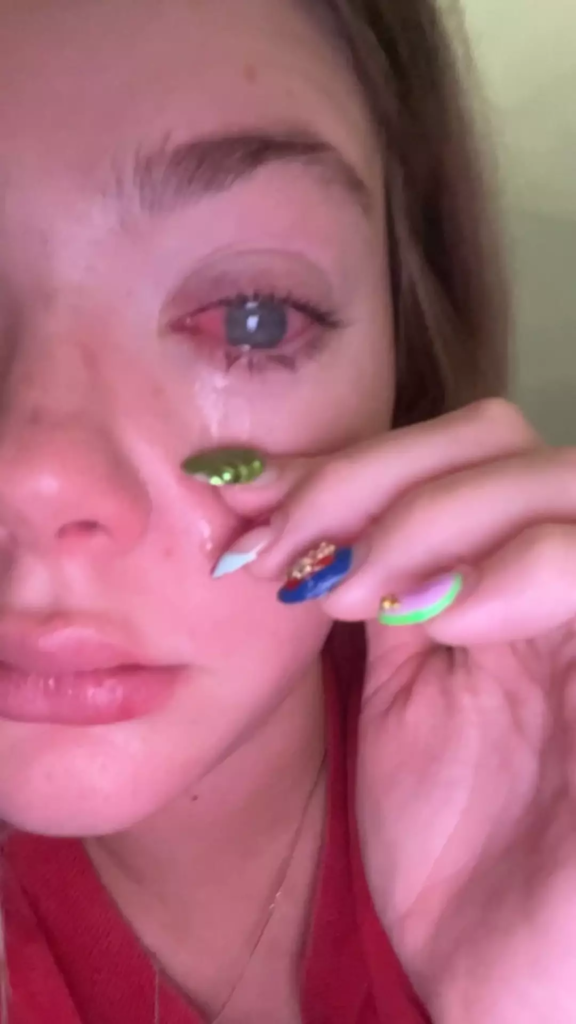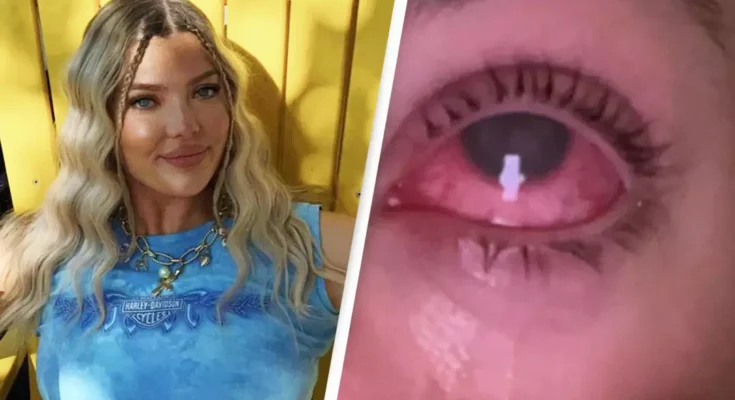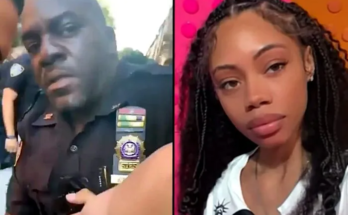Brooklyn McCasland, 23, wants to warn other contact lens wearers after being left blind in one eye and awaiting expensive surgery
Warning: This article contains graphic images and video which some readers may find distressing.
A Texas woman has spoken out to raise awareness of a mistake she made with her contact lenses after being left blind in one eye.
Brooklyn McCasland was on holiday in Alabama with her friends two months ago when she went swimming in the sea and came out with an irritated eye.
After thinking it was probably just a ‘piece of sand’ in her eye, she visited a local doctor who thought it was a ‘regular infection’, prescribed her eyedrops and antibiotics and sent her on her way.
Little did the 23-year-old realize it was definitely not just a grain of sand. Calling all contact lens wearers out there – hear this warning.

Brooklyn McCasland thought it was probably just a grain of sand caught in her eye (Kennedy News and Media)
The discovery
Brooklyn’s right eye began clouding over and so she was referred to a specialist who scanned her eye – with the results revealing a horrifying discovery.
Instead of finding just a grain of sand stuck in the barista’s eye, the specialist found acanthamoeba parasites and what’s more, they’d dug themselves into her cornea.
The Cleveland Clinic explains: “Acanthamoeba keratitis is a rare eye infection you can get from an amoeba, a microscopic creature similar to bacteria but a little more complex.”
The rare parasitic eye infection affects the cornea and ‘usually affects one eye at a time, but it can affect both’ starting by affecting the ‘outermost layer of your cornea, the epithelium’ before going deeper.
But how did the parasites get into Brooklyn’s eye in the first place?

It turns out there was a parasite infection in Brooklyn’s eye (Kennedy News and Media)
How it happened
Well, it’s reported the parasites are believed to have got into Brooklyn’s eye when she went in the sea and got trapped as a result of her wearing her contacts while swimming.
Indeed, the Cleveland Clinic notes people who wear contacts or who are immunocompromised have ‘the highest risk of contracting’ acanthamoeba keratitis.
And after getting stuck in her eye, the parasite then burrowed into the outer layer, multiplied and then the organisms essentially began eating the tissue in Brooklyn’s eye.
She explained: “I came back for one of my appointments and I was in really, really bad pain and she said I had an abrasion on my eye.
“I had to wear a patch over my eye. I couldn’t put any of my drops in for two days.
“I came back and she took the bandage off and said the abrasion had healed but my eye infection had gotten worse because we weren’t using any drops to keep the infection down.
“She put me back on the drops. I came back in two days and my abrasion was back and my infection was still worse.
“After she took the bandage off I was completely blind in my right eye. She said it should go away but it never did. I’m pretty much permanently blind in my right eye now.”
She added: “It was the worst pain I’ve ever experienced. It kind of felt like glass was in your eye.
“Sometimes if I shut my eye it would feel a little bit better but sometimes it would feel worse. It was just constant pain.”

Brooklyn was diagnosed with acanthamoeba keratitis (Kennedy News and Media)
Warnings and advice
With research indicating there ‘could be up to 1,500 cases in the US every year’, it’s important to know what to look out for when it comes to acanthamoeba keratitis.
Symptoms include:
- Redness or irritation to your eye
- Feeling like something’s stuck in your eye but you can’t see anything and washing your eye out still doesn’t help
- Your eye watering
- Being sensitive to light
- Pain in your eye
- Cloudiness to your eye
- Blurred vision
The most common way to contract the parasite is through improper contact lens use – i.e. wearing them too long, not washing your hands before application, not storing them properly, swimming with them in – injuring your eye or going into contaminated water.
Cleveland Clinic notes the condition is ‘treatable, but the best way to deal with this condition is to prevent it from happening’. But if you do contract it, there are medications available such as antiseptic drops and there are also surgical options – with Brooklyn hoping to undergo a $5,000 cornea transplant to gain back her sight in her right eye.
A GoFundMe has since been launched to help support Brooklyn who’s had to leave work and is saving up for the expensive surgery.
She reflected: “I started wearing [contact lenses] when I was seven. I wore them everywhere: to the pool, showered in my contacts and swam in my contacts. I even washed my contact case with tap water to clean it out. Now I know you’re not supposed to do it but I’ve done that for forever.
“[…] Just because it’s a rare condition, it doesn’t mean it can’t happen to you. […] People need to be careful and understand that anybody can get it.”



